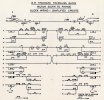There are also "one train in section" sections, normally dead-end branches, where the returning train proves the section clear by sequential operation of two track circuits. These would also have to rely on continuous brakes to address train division risk.
These are technically very similar to one end of a tokenless block section in terms of the sequence of events required for block clearance. ISTR that in addition to the track circuits operated in correct sequence, both OT and TB also require a treadle operated and then normalised again as an extra safeguard.
Here's a simplified layout and circuit diagram for a tokenless block section from
http://www.trainweb.org/railwest/gen/signal/tkblock.html
More recently these would probably be done by axle counters, which do prove that the entire train has passed out of the section.
An axle counter can have a single sensor solely at the entrance to a single track stub branch yet can provide full continuous train detection for any kind of train all the way to the buffer stops, even dealing safely with unfitted or partially fitted trains that could potentially split without both sections coming to a stand. Where an axle counter is provided on such a line, a big advantage of formally retaining the OT method of working, rather than converting to TCB, would be the avoidance of a platform starter signal for reversing at the terminus (and at any other routinely used intermediate reversing point en-route), which is a requirement for new installations under TCB regulations.
Another place where a tokenless block section routinely clears out automatically in both directions without tail-light observation is between Smallbrook Jn and the remote Sandown passing loop on the Isle of Wight. The section beyond Sandown to Shanklin is OT.
I remember being told by an 'old hand' in the WR Reading signalling drawing office that in the 1960s or 70s there was a serious proposal to formulate a new form of absolute block replacement to be known as 'Auto Block' that would have relied on similar principles to tokenless, and could have allowed remote automatic block sections on double track lines with neither remote tail light observation nor continuous track circuiting, with significant cost savings possible. Safety authorities of the time got cold feet I understand however and development was stopped, although TB (with automatic block clearance) was used for many years on the double track between Templecombe and Yeovil Junction. One of the lines was bidirectionally signalled with TB (sorry I forget which one!) although was normally only used in one direction, while the other unidirectional line used AB, which clearly needed manual block clearance with tail light observation.

